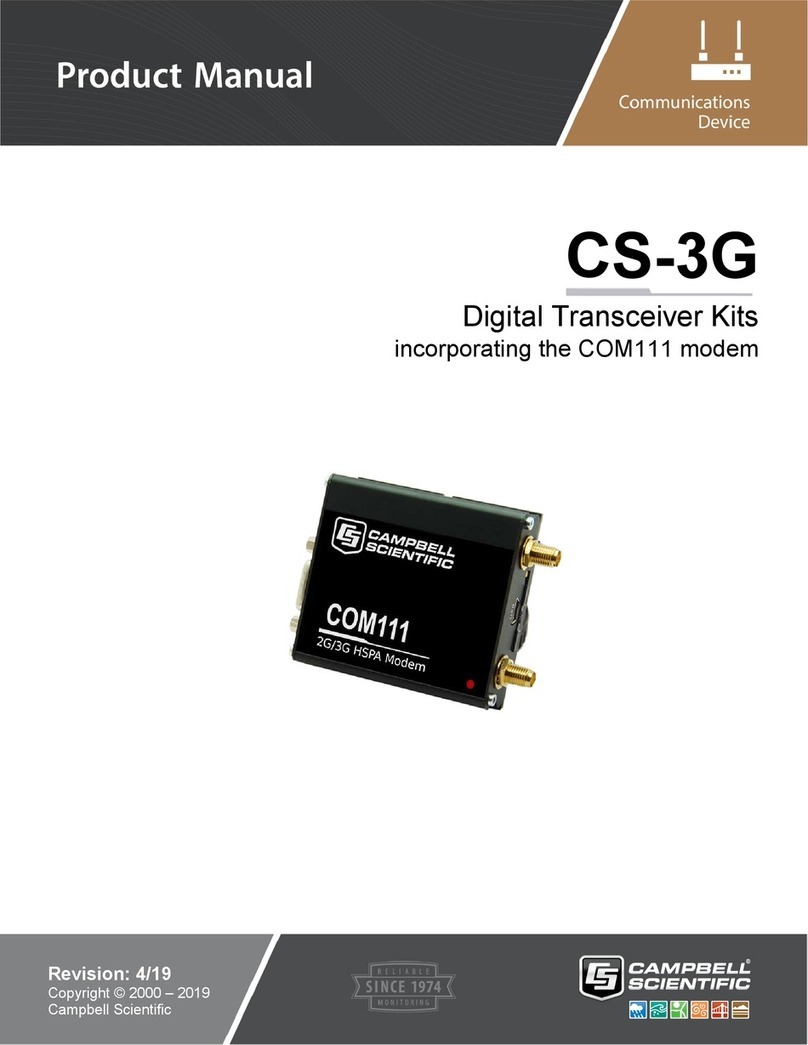
Using with Campbell Scientific Dataloggers
3
1.3 Call Charges
Call charges on cellular-based phones are usually much higher than landline based
systems and can therefore be quite high for a long-term data collection campaign.
Careful choice of the tariffs available can result in a considerable reduction in the
total bill. Obviously the tariff chosen should allow use of the phone for data
transmission. Some very low cost packages are limited to voice only, but some
companies offer cheap data-only tariffs as well. Limiting calls to off-peak and
weekend periods can also result in major cost savings.
One major factor which can determine call costs is the method used to connect to
the remote TC35T. If you call the TC35T from a landline phone modem, you will
normally pay your landline phone company the same (high) cost as calling a voice
cellphone. This is independent of your agreement with the cellphone airtime
provider. In many cases it may be cheaper to buy an extra TC35T for your base
station, thus avoiding the use of the land-based phone line altogether. This could
also enable you to benefit from the special tariffs for data-only transmission
provided by the airtime companies. Also, the set-up time from TC35T to TC35T is
usually much lower and the overall call will thus be shorter and cheaper.
If you cannot use a base station TC35T, cheaper calls may also be possible by
programming the datalogger to call back to the land-line phone base station, as the
special airtime rates will normally apply to such calls too.
Where many calls have to be made in quick succession ISDN digital landlines can
be used with a digital terminal adaptor in the calling PC. If correctly supported and
set-up for the phone account by the network operator, the connection time can be
reduced to one or two seconds. This is done by setting the system to communicate
in a digital fashion throughout (UDI mode). Please contact Campbell Scientific
Ltd for further advice on this matter.
2. Initial TC35T Setup
Before the TC35T can be used or tested, it must be fitted with a ‘SIM’ (Subscriber
Identification Module) which enables it for use on a specific cellular telephone
network in a particular frequency band. For some networks, e.g. BT Cellnet in the
U.K, you need to specify the mode of data transfer. If this is required, request it to
work in ‘non-transparent mode’ at 9600 baud. This is the default setting for most
networks. Your airtime provider will normally supply you with an extra phone
number for the SIM specifically for data use.
The TC35T does not support the older transparent mode of
communication.
If possible, ensure that the SIM is configured so that it does not require a Personal
Identification Number (PIN) security code to be entered after the module is
powered up. The PIN can most easily be disabled by inserting it into a separate,
hand-held standard GSM phone and following the instructions contained in the
phone manual. If a separate phone is not available, please contact Campbell
Scientific for details of how to disable the PIN code for use with the TC35T. If this
is not possible, or if your airtime provider only allows operation with a PIN
enabled, please refer to Appendix A.
NOTE




























